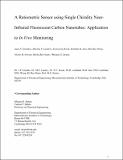A Ratiometric Sensor Using Single Chirality Near-Infrared Fluorescent Carbon Nanotubes: Application to In Vivo Monitoring
Author(s)
Giraldo, Juan P.; Jain, Rishabh M.; Wong, Min Hao; Iverson, Nicole M.; Ben-Naim, Micha; Strano, Michael S.; Landry, Markita Patricia; Kwak, Seonyeong; ... Show more Show less
DownloadGiraldo et al_2015_Small.pdf (6.765Mb)
OPEN_ACCESS_POLICY
Open Access Policy
Creative Commons Attribution-Noncommercial-Share Alike
Terms of use
Metadata
Show full item recordAbstract
Advances in the separation and functionalization of single walled carbon nanotubes (SWCNT) by their electronic type have enabled the development of ratiometric fluorescent SWCNT sensors for the first time. Herein, single chirality SWCNT are independently functionalized to recognize either nitric oxide (NO), hydrogen peroxide (H[subscript 2]O[subscript 2]), or no analyte (remaining invariant) to create optical sensor responses from the ratio of distinct emission peaks. This ratiometric approach provides a measure of analyte concentration, invariant to the absolute intensity emitted from the sensors and hence, more stable to external noise and detection geometry. Two distinct ratiometric sensors are demonstrated: one version for H[subscript 2]O[subscript 2], the other for NO, each using 7,6 emission, and each containing an invariant 6,5 emission wavelength. To functionalize these sensors from SWCNT isolated from the gel separation technique, a method for rapid and efficient coating exchange of single chirality sodium dodecyl sulfate-SWCNT is introduced. As a proof of concept, spatial and temporal patterns of the ratio sensor response to H[subscript 2]O[subscript 2] and, separately, NO, are monitored in leaves of living plants in real time. This ratiometric optical sensing platform can enable the detection of trace analytes in complex environments such as strongly scattering media and biological tissues.
Date issued
2015-05Department
Massachusetts Institute of Technology. Department of Chemical EngineeringJournal
Small
Publisher
Wiley Blackwell
Citation
Giraldo, Juan P., Markita P. Landry, Seon-Yeong Kwak, Rishabh M. Jain, Min Hao Wong, Nicole M. Iverson, Micha Ben-Naim, and Michael S. Strano. “A Ratiometric Sensor Using Single Chirality Near-Infrared Fluorescent Carbon Nanotubes: Application to In Vivo Monitoring.” Small 11, no. 32 (May 15, 2015): 3973–3984.
Version: Author's final manuscript
ISSN
16136810
1613-6829